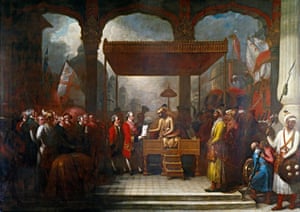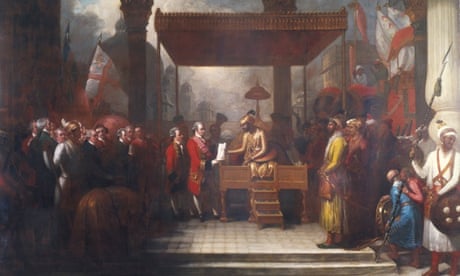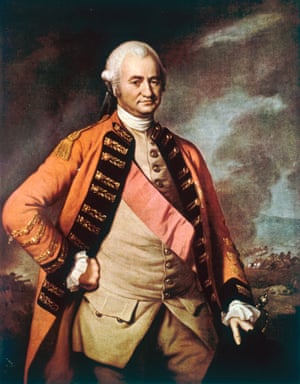For a century, the East India Company conquered, subjugated and plundered vast tracts of south Asia. The lessons of its brutal reign have never been more relevant
The Mughal emperor Shah Alam hands a scroll to Robert Clive, the governor of Bengal, which transferred tax collecting rights in Bengal, Bihar and Orissa to the East India Company. Illustration: Benjamin West (1738–1820)/British Library
 One of the very first Indian words to enter the English language was the Hindustani slang for plunder: “loot”. According to the Oxford English Dictionary, this word was rarely heard outside the plains of north Indiauntil the late 18th century, when it suddenly became a common term across Britain. To understand how and why it took root and flourished in so distant a landscape, one need only visit Powis Castle.
One of the very first Indian words to enter the English language was the Hindustani slang for plunder: “loot”. According to the Oxford English Dictionary, this word was rarely heard outside the plains of north Indiauntil the late 18th century, when it suddenly became a common term across Britain. To understand how and why it took root and flourished in so distant a landscape, one need only visit Powis Castle.
The last hereditary Welsh prince, Owain Gruffydd ap Gwenwynwyn, built Powis castle as a craggy fort in the 13th century; the estate was his reward for abandoning Wales to the rule of the English monarchy. But its most spectacular treasures date from a much later period of English conquest and appropriation: Powis is simply awash with loot from India, room after room of imperial plunder, extracted by the East India Company in the 18th century.
There are more Mughal artefacts stacked in this private house in the Welsh countryside than are on display at any one place in India – even the National Museum in Delhi. The riches include hookahs of burnished gold inlaid with empurpled ebony; superbly inscribed spinels and jewelled daggers; gleaming rubies the colour of pigeon’s blood and scatterings of lizard-green emeralds. There are talwars set with yellow topaz, ornaments of jade and ivory; silken hangings, statues of Hindu gods and coats of elephant armour.

The latest in our audio long reads examines how, for a century, the East India Company conquered, subjugated and plundered vast tracts of south Asia. The lessons of its brutal reign have never been more relevant.
Listen
Such is the dazzle of these treasures that, as a visitor last summer, I nearly missed the huge framed canvas that explains how they came to be here. The picture hangs in the shadows at the top of a dark, oak-panelled staircase. It is not a masterpiece, but it does repay close study. An effete Indian prince, wearing cloth of gold, sits high on his throne under a silken canopy. On his left stand scimitar and spear carrying officers from his own army; to his right, a group of powdered and periwigged Georgian gentlemen. The prince is eagerly thrusting a scroll into the hands of a statesmanlike, slightly overweight Englishman in a red frock coat.
The painting shows a scene from August 1765, when the young Mughal emperor Shah Alam, exiled from Delhi and defeated by East India Company troops, was forced into what we would now call an act of involuntary privatisation. The scroll is an order to dismiss his own Mughal revenue officials in Bengal, Bihar and Orissa, and replace them with a set of English traders appointed by Robert Clive – the new governor of Bengal – and the directors of the EIC, who the document describes as “the high and mighty, the noblest of exalted nobles, the chief of illustrious warriors, our faithful servants and sincere well-wishers, worthy of our royal favours, the English Company”. The collecting of Mughal taxes was henceforth subcontracted to a powerful multinational corporation – whose revenue-collecting operations were protected by its own private army.
It was at this moment that the East India Company (EIC) ceased to be a conventional corporation, trading and silks and spices, and became something much more unusual. Within a few years, 250 company clerks backed by the military force of 20,000 locally recruited Indian soldiers had become the effective rulers of Bengal. An international corporation was transforming itself into an aggressive colonial power.
Using its rapidly growing security force – its army had grown to 260,000 men by 1803 – it swiftly subdued and seized an entire subcontinent. Astonishingly, this took less than half a century. The first serious territorial conquests began in Bengal in 1756; 47 years later, the company’s reach extended as far north as the Mughal capital of Delhi, and almost all of India south of that city was by then effectively ruled from a boardroom in the City of London. “What honour is left to us?” asked a Mughal official named Narayan Singh, shortly after 1765, “when we have to take orders from a handful of traders who have not yet learned to wash their bottoms?”
It was not the British government that seized India, but a private company, run by an unstable sociopath
We still talk about the British conquering India, but that phrase disguises a more sinister reality. It was not the British government that seized India at the end of the 18th century, but a dangerously unregulated private company headquartered in one small office, five windows wide, in London, and managed in India by an unstable sociopath – Clive.
In many ways the EIC was a model of corporate efficiency: 100 years into its history, it had only 35 permanent employees in its head office. Nevertheless, that skeleton staff executed a corporate coup unparalleled in history: the military conquest, subjugation and plunder of vast tracts of southern Asia. It almost certainly remains the supreme act of corporate violence in world history. For all the power wielded today by the world’s largest corporations – whether ExxonMobil, Walmart or Google – they are tame beasts compared with the ravaging territorial appetites of the militarised East India Company. Yet if history shows anything, it is that in the intimate dance between the power of the state and that of the corporation, while the latter can be regulated, it will use all the resources in its power to resist.
 When it suited, the EIC made much of its legal separation from the government. It argued forcefully, and successfully, that the document signed by Shah Alam – known as the Diwani – was the legal property of the company, not the Crown, even though the government had spent a massive sum on naval and military operations protecting the EIC’s Indian acquisitions. But the MPs who voted to uphold this legal distinction were not exactly neutral: nearly a quarter of them held company stock, which would have plummeted in value had the Crown taken over. For the same reason, the need to protect the company from foreign competition became a major aim of British foreign policy.
When it suited, the EIC made much of its legal separation from the government. It argued forcefully, and successfully, that the document signed by Shah Alam – known as the Diwani – was the legal property of the company, not the Crown, even though the government had spent a massive sum on naval and military operations protecting the EIC’s Indian acquisitions. But the MPs who voted to uphold this legal distinction were not exactly neutral: nearly a quarter of them held company stock, which would have plummeted in value had the Crown taken over. For the same reason, the need to protect the company from foreign competition became a major aim of British foreign policy.
FacebookTwitterPinterest Robert Clive, was an unstable sociopath who led the fearsome East India Company to its conquest of the subcontinent. Photograph: Hulton Archive/Hulton Archive/Getty Images
The transaction depicted in the painting was to have catastrophic consequences. As with all such corporations, then as now, the EIC was answerable only to its shareholders. With no stake in the just governance of the region, or its long-term wellbeing, the company’s rule quickly turned into the straightforward pillage of Bengal, and the rapid transfer westwards of its wealth.
Before long the province, already devastated by war, was struck down by the famine of 1769, then further ruined by high taxation. Company tax collectors were guilty of what today would be described as human rights violations. A senior official of the old Mughal regime in Bengal wrote in his diaries: “Indians were tortured to disclose their treasure; cities, towns and villages ransacked; jaghires and provinces purloined: these were the ‘delights’ and ‘religions’ of the directors and their servants.”
Bengal’s wealth rapidly drained into Britain, while its prosperous weavers and artisans were coerced “like so many slaves” by their new masters, and its markets flooded with British products. A proportion of the loot of Bengal went directly into Clive’s pocket. He returned to Britain with a personal fortune – then valued at £234,000 – that made him the richest self-made man in Europe. After the Battle of Plassey in 1757, a victory that owed more to treachery, forged contracts, bankers and bribes than military prowess, he transferred to the EIC treasury no less than £2.5m seized from the defeated rulers of Bengal – in today’s currency, around £23m for Clive and £250m for the company.

No great sophistication was required. The entire contents of the Bengal treasury were simply loaded into 100 boats and punted down the Ganges from the Nawab of Bengal’s palace to Fort William, the company’s Calcutta headquarters. A portion of the proceeds was later spent rebuilding Powis.
The painting at Powis that shows the granting of the Diwani is suitably deceptive: the painter, Benjamin West, had never been to India. Even at the time, a reviewer noted that the mosque in the background bore a suspiciously strong resemblance “to our venerable dome of St Paul”. In reality, there had been no grand public ceremony. The transfer took place privately, inside Clive’s tent, which had just been erected on the parade ground of the newly seized Mughal fort at Allahabad. As for Shah Alam’s silken throne, it was in fact Clive’s armchair, which for the occasion had been hoisted on to his dining room table and covered with a chintz bedspread.
Later, the British dignified the document by calling it the Treaty of Allahabad, though Clive had dictated the terms and a terrified Shah Alam had simply waved them through. As the contemporary Mughal historian Sayyid Ghulam Husain Khan put it: “A business of such magnitude, as left neither pretence nor subterfuge, and which at any other time would have required the sending of wise ambassadors and able negotiators, as well as much parley and conference with the East India Company and the King of England, and much negotiation and contention with the ministers, was done and finished in less time than would usually have been taken up for the sale of a jack-ass, or a beast of burden, or a head of cattle.”
By the time the original painting was shown at the Royal Academy in 1795, however, no Englishman who had witnessed the scene was alive to point this out. Clive, hounded by envious parliamentary colleagues and widely reviled for corruption, committed suicide in 1774 by slitting his own throat with a paperknife some months before the canvas was completed. He was buried in secret, on a frosty November night, in an unmarked vault in the Shropshire village of Morton Say. Many years ago, workmen digging up the parquet floor came across Clive’s bones, and after some discussion it was decided to quietly put them to rest again where they lay. Here they remain, marked today by a small, discreet wall plaque inscribed: “PRIMUS IN INDIS.”
Today, as the company’s most articulate recent critic, Nick Robins, has pointed out, the site of the company’s headquarters in Leadenhall Street lies underneath Richard Rogers’s glass and metal Lloyd’s building. Unlike Clive’s burial place, no blue plaque marks the site of what Macaulay called “the greatest corporation in the world”, and certainly the only one to equal the Mughals by seizing political power across wide swaths of south Asia. But anyone seeking a monument to the company’s legacy need only look around. No contemporary corporation could duplicate its brutality, but many have attempted to match its success at bending state power to their own ends.
The people of Allahabad have also chosen to forget this episode in their history. The red sandstone Mughal fort where the treaty was extracted from Shah Alam – a much larger fort than those visited by tourists in Lahore, Agra or Delhi – is still a closed-off military zone and, when I visited it late last year, neither the guards at the gate nor their officers knew anything of the events that had taken place there; none of the sentries had even heard of the company whose cannons still dot the parade ground where Clive’s tent was erected.
Instead, all their conversation was focused firmly on the future, and the reception India’s prime minister, Narendra Modi, had just received on his trip to America. One of the guards proudly showed me the headlines in the local edition of the Times of India, announcing that Allahabad had been among the subjects discussed in the White House by Modi and President Obama. The sentries were optimistic. India was finally coming back into its own, they said, “after 800 years of slavery”. The Mughals, the EIC and the Raj had all receded into memory and Allahabad was now going to be part of India’s resurrection. “Soon we will be a great country,” said one of the sentries, “and our Allahabad also will be a great city.”
At the height of the Victorian period there was a strong sense of embarrassment about the shady mercantile way the British had founded the Raj. The Victorians thought the real stuff of history was the politics of the nation state. This, not the economics of corrupt corporations, they believed was the fundamental unit of analysis and the major driver of change in human affairs. Moreover, they liked to think of the empire as a mission civilisatrice: a benign national transfer of knowledge, railways and the arts of civilisation from west to east, and there was a calculated and deliberate amnesia about the corporate looting that opened British rule in India.
A second picture, this one commissioned to hang in the House of Commons, shows how the official memory of this process was spun and subtly reworked. It hangs now in St Stephen’s Hall, the echoing reception area of parliament. I came across it by chance late this summer, while waiting there to see an MP.
The painting was part of a series of murals entitled the Building of Britain. It features what the hanging committee at the time regarded as the highlights and turning points of British history: King Alfred defeating the Danes in 877, the parliamentary union of England and Scotland in 1707, and so on. The image in this series which deals with India does not, however, show the handing over of the Diwani but an earlier scene, where again a Mughal prince is sitting on a raised dais, under a canopy. Again, we are in a court setting, with bowing attendants on all sides and trumpets blowing, and again an Englishman is standing in front of the Mughal. But this time the balance of power is very different.
Sir Thomas Roe, the ambassador sent by James I to the Mughal court, is shown appearing before the Emperor Jahangir in 1614 – at a time when the Mughal empire was still at its richest and most powerful. Jahangir inherited from his father Akbar one of the two wealthiest polities in the world, rivalled only by Ming China. His lands stretched through most of India, all of what is now Pakistan and Bangladesh, and most of Afghanistan. He ruled over five times the population commanded by the Ottomans – roughly 100 million people. His capitals were the megacities of their day.
 In Milton’s Paradise Lost, the great Mughal cities of Jahangir’s India are shown to Adam as future marvels of divine design. This was no understatement: Agra, with a population approaching 700,000, dwarfed all of the cities of Europe, while Lahore was larger than London, Paris, Lisbon, Madrid and Rome combined. This was a time when India accounted for around a quarter of all global manufacturing. In contrast, Britain then contributed less than 2% to global GDP, and the East India Company was so small that it was still operating from the home of its governor, Sir Thomas Smythe, with a permanent staff of only six. It did, however, already possess 30 tall ships and own its own dockyard at Deptford on the Thames.
In Milton’s Paradise Lost, the great Mughal cities of Jahangir’s India are shown to Adam as future marvels of divine design. This was no understatement: Agra, with a population approaching 700,000, dwarfed all of the cities of Europe, while Lahore was larger than London, Paris, Lisbon, Madrid and Rome combined. This was a time when India accounted for around a quarter of all global manufacturing. In contrast, Britain then contributed less than 2% to global GDP, and the East India Company was so small that it was still operating from the home of its governor, Sir Thomas Smythe, with a permanent staff of only six. It did, however, already possess 30 tall ships and own its own dockyard at Deptford on the Thames.
No comments:
Post a Comment